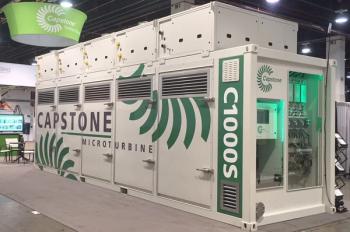
NEAR ISOTHERMAL COMPRESSION
ADVANCED BRAYTON CYCLE TURBINE MODIFICATIONS CAN BOOST POWER, LOWER HEAT RATE AND EMISSIONS
According to thermodynamic principles, when the temperature of gases entering a turbine exceeds the temperature of gases entering the compressor, the turbine can deliver more power than the compressor consumes. Therefore the engine can produce a net power output (contingent upon other criteria being met).
The efficiency with which the engine converts heat energy into mechanical energy depends on many factors including compressor and turbine efficiencies, temperature levels, pressure ratio, and the presence or absence of enhancements, such as regeneration and compressor air-stream cooling. The power produced is proportional to the efficiency as well as the mass flow rates of air and fuel.
Conventional gas turbines operate approximately according to the ideal gas turbine or Brayton cycle, which embodies reversible adiabatic (without heat transfer) compression of atmospheric air, addition of heat at constant pressure, reversible adiabatic expansion through a turbine back to atmospheric pressure, and exhausting to the atmosphere.
Regeneration greatly improves fuel economy by recovering much of the exhaust heat. When regeneration is employed, the cycle is designated a regenerated Brayton Cycle.
In a non-regenerated engine, lowering the compressor-discharge temperature causes an increase in the fuel flow rate needed to maintain the turbine inlet temperature at its set value. However, the incremental increase in the required combustion heat is matched by an incremental increase in the net power output.
Then efficiency, being net-power divided by combustion-heat-rate, also increases with compressor cooling. When regeneration is coupled with compressor cooling, efficiency increases even more.
Isothermal compression
Isothermal compression is impossible to achieve. But by removing heat stage-bystage from the compressor by water cooling the stator vanes, and by adding heat fins to increase air-side surface area, the work required to compress air can be reduced.
Internal compressor cooling, however, is a means of expelling much of the compression heat in order to reduce power consumption by the compressor.
Unlike previous attempts to approximate isothermal compression, the transfer of heat to the coolant takes place inside the compressor. Only the coolant circulates through an external heat exchanger (radiator). Airflow paths through the compressor are largely unchanged from those of uncooled compressors.
Ideally, all of the compression heat would be removed and the temperature would remain constant throughout compression. Overall benefit is measured by its proximity to this ideal. Cooling effectiveness is then a measure of the amount of heat actually extracted from the compressor air stream divided by the total amount that would be necessary to achieve isothermal compression.
By implementing stage-by-stage cooling of hollow stator vanes it is possible to cool the compressor air flow and the compressor housing. Careful attention is paid to stall margin and operating conditions to achieve a significant >10% heat rate reduction.
Computations based on laws of thermodynamics predict that both stator vane cooling with the addition of heat fins and waterjacketing the compressor housing enables the extraction of significant heat, most of which transfers from the compressor air by forced convection to the stator blades and the inside of the housing.
Since the rotor blades do not touch the housing, there is no solid conduction of heat between them; however, the forced convection heat transfer between the rotor air stream and the housing is high.
Helicopter gas turbine
Rotorcraft using the Rolls-Royce Model 250 C20 series gas turbine can improve power by up to 15% and reduce fuel consumption by 5% using this near-isothermal cooling approach. In this case, the retrofit replaced the existing compressor housing with new stator blades and a water-cooled housing, allowing heat to be extracted during compression and ejected via radiator to the atmosphere. Helicopter operators can benefit (once approved by the FAA) from lowered fuel expense and improved range and endurance.
The same principal can be applied to the Rolls-Royce Model 501K industrial gas turbine which is currently under a design effort by Frontline Aerospace. With this retrofit, de-mineralized water circulates through the stator vanes, removing heat from the compression process.
Consequently, output power increases by 9% to 15% at the same heat rate, depending on the turbine. Or the heat rate decreases by 7% to 10% at the same power output. Higher pressure ratio turbines offer more potential for power increase and reduced heat rate. Additionally, since the compressor discharge air is cooler, the hot turbine temperature will be reduced and the air cooled turbine blades will have a longer life (Figure 1).
Investigation is ongoing into the use of water bleed holes on the stator vanes. Small amounts of de-mineralized water can be injected to clean the compressor, reduce fouling and provide additional evaporative cooling. This could reduce or eliminate the need for compressor washes.
Also in the Rolls-Royce 501-K example, since the compressor case and stator vanes are being replaced, new seals can be implemented for the first time further improving compressor efficiency and stall margin.
Some of the compressed discharge air from the Rolls-Royce 501-K turbine is used to cool the hot turbine blades. But as nearisothermal cooling lowers the compressor air temperature, the turbine inlet temperature (TIT) can be increased, thereby yielding more even power and better heat rate.
By implementing compressor air cooling, reductions in heat rate and increases in shaft power can be achieved by swapping compressor cases and minor system changes.
This adds flexibility: At certain times the focus can be on lower heat rates (fuel expense), and at others, higher power output depending on the application. Conservative heat-rate improvements of 10% and power gains of 15% are attainable on smaller engines.
Authors
Dr. W. Gene Steward is Senior Scientist at Frontline Aerospace, the developer of IsoCool compressor cooling technology, a means of expelling much of the compression heat in order to reduce power consumption by the compressor.
Ryan S. Wood is the CEO of Frontline Aerospace. For more information visit www.frontlineaerospace.com
Newsletter
Power your knowledge with the latest in turbine technology, engineering advances, and energy solutions—subscribe to Turbomachinery International today.





